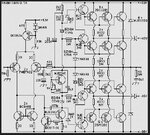Easy peasy
Advanced Member level 6
Hello all, we are looking to make some in house test gear - for this we need a linear source +200V to - 200V sine wave, 1A
Glass G looks to be a good low noise solution ( switch mode too noisy ), and a wee bit more efficient than class AB
does anyone have the bones of a good class-G design that could be scaled up to the 200Vpk ( 400Vp-p ) needed
or point to real circuit links that might be useful - please? ( BJT / IGBT / mosfet / SiC mosfet all OK )
kind regards, EP.
Glass G looks to be a good low noise solution ( switch mode too noisy ), and a wee bit more efficient than class AB
does anyone have the bones of a good class-G design that could be scaled up to the 200Vpk ( 400Vp-p ) needed
or point to real circuit links that might be useful - please? ( BJT / IGBT / mosfet / SiC mosfet all OK )
kind regards, EP.
